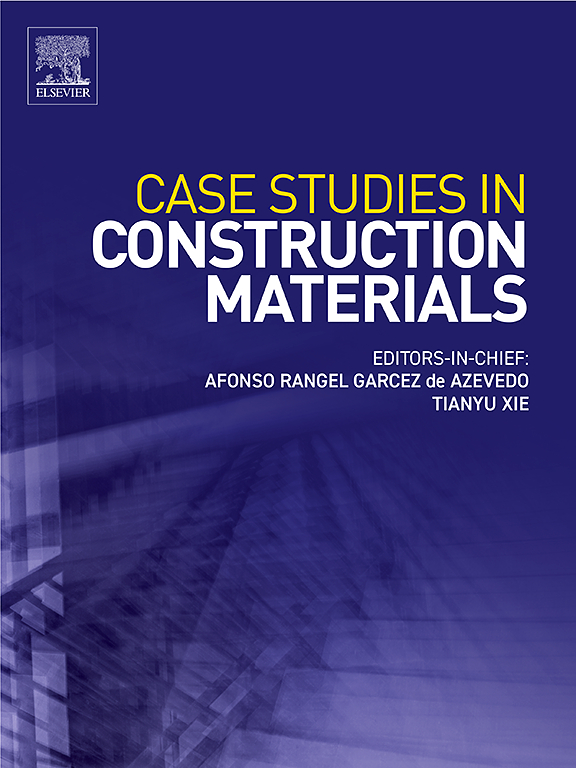模型室试验评价不同施工条件下联锁砌块路面性能
IF 6.5
2区 工程技术
Q1 CONSTRUCTION & BUILDING TECHNOLOGY
引用次数: 0
摘要
随着对互锁块路面(IBPs)的需求不断增长,以适应不同的交通荷载,全面了解施工条件(如砌块厚度、接缝宽度和层理厚度)对IBP性能的影响至关重要。本研究通过一系列重复加载试验解决了这些因素,对100 mm厚的普通块体的层理厚度为30、50和80 mm,接缝宽度为5和8 mm,对160 mm厚的重型块体的层理厚度为50、80和110 mm,接缝宽度为5 mm的模型IBPs进行了一系列重复加载试验。IBPs的性能评估主要基于抗挠度、载荷分散能力和联锁效应,后者通过相邻块体的相对挠度来评估,这是IBPs抗载荷的关键机制。结果表明,当层理厚度为50 mm,节理宽度为5 mm时,一般块体的联锁效果增强。此外,重型区块需要增加80 mm的层理厚度,以实现更大的联锁。在这些条件下,砌块充分旋转以产生拱形效应和较高的相对挠度。相反,在不适当的条件下建造的ibp则出现车辙破坏,由于过度的应力传递到基底和层理砂运移,最大块体隆升0.374 mm。最后,在最优施工条件下,普通砌块和重型砌块的弹性模量分别达到5417.06和2075.45 MPa。本研究强调了结构因素在确保IBP性能中的重要性,并建议挠度和联锁效应应被视为关键性能指标。本文章由计算机程序翻译,如有差异,请以英文原文为准。
Evaluation of interlocking block pavement performance under varying construction conditions by model chamber tests
As the demand for interlocking block pavements (IBPs) grows to accommodate diverse traffic loads, it is crucial to comprehensively understand how construction conditions, such as block thickness, joint width, and bedding thickness, affect IBP performance. This study addresses these factors through a series of repeated loading tests on model IBPs constructed with bedding thicknesses of 30, 50, and 80 mm and joint widths of 5 and 8 mm for 100 mm-thick general blocks, and bedding thicknesses of 50, 80, and 110 mm with a joint width of 5 mm for 160 mm-thick heavy-duty blocks. The performance of IBPs was evaluated based on deflection resistance, load-dispersion ability, and interlocking effect, the latter being assessed through the relative deflection of adjoining blocks, a key mechanism for load resistance in IBPs. The results demonstrated that an enhanced interlocking effect was achievable with a bedding thickness of 50 mm and a joint width of 5 mm for general blocks. Additionally, heavy-duty blocks required an increased bedding thickness of 80 mm to achieve greater interlocking. Under these conditions, the blocks rotated sufficiently to produce an arching effect and higher relative deflection. Conversely, IBPs constructed under inadequate conditions exhibited rutting failures, with a maximum block uplift of 0.374 mm due to excessive stress transmission to the base and bedding sand migration. Finally, the elastic modulus, estimated from transmitted stress, reached higher values of 5417.06 and 2075.45 MPa for general and heavy-duty blocks, respectively, under optimal construction conditions. This study highlights the importance of construction factors in ensuring IBP performance and suggests that both deflection and interlocking effect should be considered key performance indicators.
求助全文
通过发布文献求助,成功后即可免费获取论文全文。
去求助
来源期刊

Case Studies in Construction Materials
Multiple-
CiteScore
7.60
自引率
19.40%
发文量
842
审稿时长
63 days
期刊介绍:
Case Studies in Construction Materials provides a forum for the rapid publication of short, structured Case Studies on construction materials. In addition, the journal also publishes related Short Communications, Full length research article and Comprehensive review papers (by invitation).
The journal will provide an essential compendium of case studies for practicing engineers, designers, researchers and other practitioners who are interested in all aspects construction materials. The journal will publish new and novel case studies, but will also provide a forum for the publication of high quality descriptions of classic construction material problems and solutions.
 求助内容:
求助内容: 应助结果提醒方式:
应助结果提醒方式:


